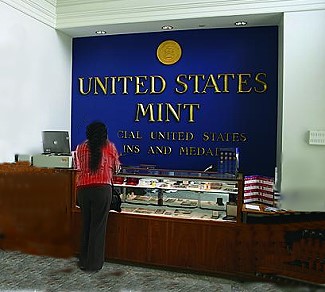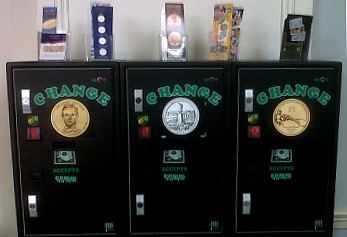By Louis Golino for CoinWeek ………
Longtime Numismatic News editor David Harper likes to write provocative columns and online posts. I do too, as they can help get debate going. In a “The Buzz” blog post dated September 10th, he noted that the U.S. Mint plans to close its coin sales kiosk (really just a sales counter) at Union Station in Washington, DC due to rising rent costs and wonders if buyers will care. Of course, that all depends on which buyers. Those who never buy in person from the Mint will obviously not be likely to care much, but those who do will not be happy about this development.
I was at U.S. Mint headquarters last week, where the Mint also has a sales counter, to pick up some of the new Fort McHenry America the Beautiful quarters at face value, and learned of the planned closure, which is set for the end of September.
 In addition to selling almost everything they sell online at the sales kiosks, including the Mint’s bronze medals, the Mint also has a change machine, where you can turn $1, $5, and $10 bills into whatever quarter was released most recently. Because these quarters are not available from most banks and so hard to find even in change, I really like being able to get them there at no premium and give them out to people to make them aware of the current quarter program. The launch ceremony for the new quarter will be held in Baltimore, Maryland on September 13.
In addition to selling almost everything they sell online at the sales kiosks, including the Mint’s bronze medals, the Mint also has a change machine, where you can turn $1, $5, and $10 bills into whatever quarter was released most recently. Because these quarters are not available from most banks and so hard to find even in change, I really like being able to get them there at no premium and give them out to people to make them aware of the current quarter program. The launch ceremony for the new quarter will be held in Baltimore, Maryland on September 13.
While I was at the Mint, there were several other people getting quarters too and buying collectible coins as well. I even struck up a new coin friendship with a gentleman there, who was trying to decide what coins to buy. He ended up buying the coins I recommended and left knowing all about CoinWeek!
In his column Mr. Harper suggests that it may be time to stop all physical coin sales by the Mint because of declining sales of numismatic coins, rising costs, and certain restrictions on the Mint’s ability to sell its wares in Union Station such as signage restrictions.
I must disagree strongly with this proposal, which would hurt buyers of Mint products, reduce the Mint’s revenues, and decrease the number of people exposed to modern U.S. Mint collector coins, which hurts numismatics as a whole.
First of all, it is important to understand that the Mint’s various physical sales facilities are not all the same.
At the Mint in Philadelphia and Denver a company called Aramark operates gift shops which sell Mint coins, and the Mint leases the space for those shops to the company. As far as I can determine, there are no costs to the Mint associated with those facilities, which Mr. Harper does not specifically reference, but they fall under his rubric of “physical coin sales.”
And the coins themselves are produced at a fraction of their retail price in most cases and bring in substantial revenue. Visitors to these Mints appreciate the opportunity to buy coins in person whether as a memento of their trip to the Mint, or to buy coins in person others have to buy online or over the telephone.
 Second, the Mint’s Washington, DC sales counters are two different animals. The one at Union Station does require the leasing of some space in downtown Washington, DC at the city’s landmark train station. Many businesses have had to relocate from downtown because of very costly rents, and looking for a new location with lower rent costs, as the Mint is reportedly doing and as Mr. Harper mentioned, makes a lot of sense to me.
Second, the Mint’s Washington, DC sales counters are two different animals. The one at Union Station does require the leasing of some space in downtown Washington, DC at the city’s landmark train station. Many businesses have had to relocate from downtown because of very costly rents, and looking for a new location with lower rent costs, as the Mint is reportedly doing and as Mr. Harper mentioned, makes a lot of sense to me.
It will be important to advertise the new location so buyers know where to go, but a Mint employee, who spoke to me recently and who did not want to be identified, said that the Mint has been discussing the possibility of new sales locations for years, and he sounded skeptical about the possibility of this happening. I hope that turns out to be wrong.
The sales counter the Mint operates in the lobby of its headquarters building on Ninth Street in Washington is very different. It is located at the main entrance of the building that is already staffed by Mint security officials, so no additional security is required to run the sales counter.
The Mint leases the entire building, some of which it subleases to other government agencies at cost, so there is no extra cost in terms of rent. And as far as I know, the main cost is the salaries of the couple of people who work there, who all provide friendly and knowledgeable service to buyers whether they are casual customers, people passing through a part of the city that has many large hotels that cater to business travelers and others attending conferences, and regular Mint customers, who sometimes come in from nearby suburbs and other surrounding areas so they can buy their coins in person.
In addition, the Mint employees who sell coins there also attend some major coin shows where they sell coins, and probably perform other duties too. If they were not staffing the counters, they would be doing something else, so I see no net cost to operate the headquarters facility.
A big part of the appeal for those who purchase their reverse proof American Buffalo gold coins at the 2012 Chicago ANA World’s Fair of Money was the desire to see the coin before buying and hold it in their hands. The same appeal applies to those who purchase from the Mint’s Washington, DC sales facilities, especially for those buying coins of substantial value.
I also have little doubt, in fact, know for a fact that people who previously had no interest in coins and knew nothing about U.S. Mint products became regular buyers after stopping by one of these kiosks during a trip to Washington, a city that is constantly visited by people for business or pleasure.
What better way is there to bring in new members to numismatics, and to get more people interested in modern American coins? Plus, the Mint does not do a lot of advertising that is targeted at the non-collector, and having sales facilities in busy parts of the nation’s Capitol increases the Mint’s visibility substantially.
I always enjoy visiting the sales counters and it makes a huge difference to me to see coins in person and bring them home with me instead of waiting on the mail and worrying they might get lost or stolen while in transit.
The Union Station facility, it should be noted, used to be open seven days a week and stayed open until 9:00pm during the work week to accommodate people coming after work in a city where many people work very late. But the hours and days of service were cut back over the past year. The Mint’s headquarters sales kiosk closes at 4:00pm, and is only open Monday-Friday. If the Mint does rent another facility, it would be helpful to have extended hours there.
At a minimum there is no reason to close the Mint’s sales counter at its headquarters, and fortunately no plans to do so.
Finally, it is also a bit of a red herring to use declining sales of numismatic coins as a reason for closing the sales kiosks. The Mint earns various kinds of revenue from bullion and numismatic coins and from seigniorage, or the difference between the cost to make a coin and its face value.
Those revenue levels ebb and flow every year for all kinds of reasons. In the case of 2012 declines in numismatic revenue had a lot to do with high bullion prices for much of the year, which drove retail coin prices higher.
No matter how much revenue the kiosks generate*, their revenues, like those of the Mint as a whole, or of any business, cannot always go up. The bottom line is what matters, and not having the kiosks would mean less revenue for the Mint and less money going to reduce the deficit.
Please weigh in on this issue and leave your comments. If you were visiting Washington, DC, would you go to the Mint to see and possibly buy coins at the kiosk there?
*The Mint provided the following information on sales at the kiosks, which explains that the headquarters facility has been doing more business than the one at Union Station while also being run with no rent cost:
U.S. Mint: ” As of the end of August 2013, our Headquarters kiosk has had a sales total for this fiscal year (FY2013) of $1,010,660. For the same period (11 months of the fiscal year), Union Station sales are $1,152,771.
- We pay nothing for the space in Headquarters. At Union Station, we pay $180K per year plus overage rent. (Overage rent is 6% on sales over $100K for any given month).
- Headquarters is the only sales channel with three consistent years of sales growth over the previous year
- Union Station sales are down from last fiscal year (FY2012). Last year’s sales were $1,375,097. (Off $225K with a month to go. We probably will not achieve that $225K amount).
- Headquarters is $41K off of last year with a month to go. We should eclipse last year’s sales.”
 Louis Golino is a coin collector and numismatic writer, whose articles on coins have appeared in Coin World, Numismatic News, and a number of different coin web sites. His column for CoinWeek, “The Coin Analyst,” covers U.S. and world coins and precious metals. He collects U.S. and European coins and is a member of the ANA, PCGS, NGC, and CAC. He has also worked for the U.S. Library of Congress and has been a syndicated columnist and news analyst on international affairs for a wide variety of newspapers and web sites.
Louis Golino is a coin collector and numismatic writer, whose articles on coins have appeared in Coin World, Numismatic News, and a number of different coin web sites. His column for CoinWeek, “The Coin Analyst,” covers U.S. and world coins and precious metals. He collects U.S. and European coins and is a member of the ANA, PCGS, NGC, and CAC. He has also worked for the U.S. Library of Congress and has been a syndicated columnist and news analyst on international affairs for a wide variety of newspapers and web sites.





date of gold coin sale at ana is 2013
Thanks, John.
I was suprised to find out they had a kiosks at all. I knew abour the counters in Philly, Dwnver, and San Fran but not washington DC. I would like sonething like that in Houston. If they would like to expand there existing markets here in houston we have the airport postoffice which has late hours all week. How much does the mint have to pay for space from another federal agency? Two colectors items just like wall mart one stop shopping. Walmart wont deliver your snail mail though. Retail centers is a outstanding idea. Sure, like all sales there is work involved but I like the concept. This will probibly go the same discution as the penny insted of finding a way to make it work lets try to find away to do away with it. This is how a bean counter views things not a coin collecter. Bean counters job is to point out heavy expenses they are just like critics who offer no solutions just point out problems. I hope they expand this marketing tool to citys who dont have a mint. My drive to the airport is less than the price of the gas to get there and home verses what the online catalog charges to ship. The author summed it up best when he said you can see what your buying.
I am not surprised you never heard of them, John. I find the same reaction almost every time I tell someone about them. I really think the Mint should get the word out about the sales centers.
I was in Vancouver Canada last week and saw a Canadian Mint storefront retail shop downtown. We went inside and were surprised by the coin displays and amount of business on a Saturday. The US Mint should copy their stores.
Thanks for your comments, John and Matt. I totally agree they should expand, especially since so few Americans have any idea the Mint even makes coins like the 5 oz ATB’s, reverse proof Buffalos, etc. and so many more collectors would buy in person if they could. However, unless or until overall numismatic sales increase substantially for the Mint, I doubt they will expand to cities that don’t have a Mint. But they could and should sell, for examp,e the 5 oz coins at the national parks, and the quarters, and some of the commemorative issues are sometimes sold through other channels.
They must also have a secure location for overnight safe storage.
It is a shame they are closing Union Station’s kiosk as I frequented it at one time, as well as HQ.
The bonus was the traffic and the hours.
I’m not sure where else in the city has that kind of traffic and a secure facility.
I ran into locals and travellers buying at Union Station.
The proposal to stop physical coins sales should have been clarified if the author meant closing sales counters and kiosks or something else.
It seems neither have numbers to back up either keeping or closing.
I do not have them either.
Do they have a history of profitability? How does the rent rise impact that? There was a kiosk on the other side of the door that closed last year, is someone new there? Perhaps if it still unoccupied, that is good leverage for rent negotiations. It is a small space, perhaps they could find another location in Union Station? There is a non-prime location on the other side of the wall backing the long sign above the wooden cabinets.